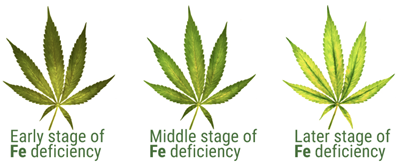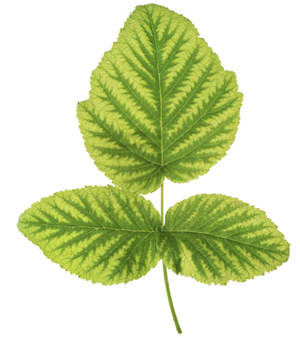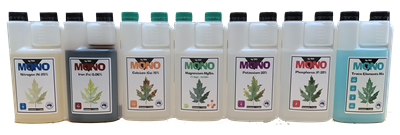THC Mono Iron (Fe) 1L
$40.00
THC Mono Iron (Fe) 0.06%
(EDDHA 0.03% + EDTA 0.03%)
Iron (Fe) deficiency is a plant disorder also known as "lime-induced chlorosis". It can be confused with manganese deficiency. Unlike in hydroponics, deficiency in the soil is rare but iron can be unavailable for absorption if soil or substrate pH is not between about 5 and 6.5. A common problem is excessive alkalinity (the pH is above 6.5). Also, iron deficiency can develop if the soil is too waterlogged or has been overfertilised. Elements like calcium, zinc, manganese, phosphorus, or copper can tie up iron if they are present in high amounts.
Iron is needed to produce chlorophyll, hence its deficiency causes chlorosis (yellow plant syndrome). For example, iron is used in the active site of glutamyl-tRNA reductase, an enzyme needed for the formation of 5-Amino acid which is a precursor of heme and chlorophyll.
Symptoms include leaves turning yellow or brown in the margins between the veins which may remain green, while young leaves may appear to be bleached. Fruit would be of poor quality and quantity. Any plant may be affected, but raspberries and pears are particularly susceptible, as well as most acid-loving plants such as azaleas and camellias.

we can tell you with confidence that yellow leaves will probably be the first indication a problem has already developed.
Iron deficiency is often misdiagnosed, routinely confused with calcium and magnesium deficiencies. Looking for yellow leaves is not enough; the grower must carefully inspect unhealthy cannabis plants. Literally from top to bottom. Precision is required to treat effectively.
Iron deficiency will be visible in the upper parts of the plant. Targeting the newest, freshest growth. In contrast, magnesium deficiency is often associated with leaves yellowing in the lower to middle portions of the plant.
Deficiency Reasons:
The pH in the root environment is too high (pH> 6,5).
The root environment contains a lot of zinc and/or manganese.
The concentration of iron is too low in the root environment.
The root temperature is low.
The root medium is too wet, causing the oxygen supply in the roots to lockout.
The root system functions inefficiently due to damaged, infected or dead roots.
There is too much light on the nutrition tank; light promotes the growth of algae. Algae also use up the iron and break down iron chelates.
Deficiency Solutions:
Lower the pH.
Iron chelates can be added to the substrate.
Drainage can be improved, or the ground temperature can be increased.
A leaf nutrient with iron chelates can possibly be applied. If a good fertiliser is used with hydroponic growing, an iron deficiency is almost out of the question.
The best thing you can do is spray the plants with a watery solution of EDDHA - (max. 0.1 grams per litre) or EDTA chelates (max. 0.5 grams per litre).

Iron plays important role in many plant functions, including: Chlorophyll development and function, energy transfer, nitrogen fixation, plant respiration and plant metabolism.
Iron deficiency can have a significant economic impact depending on the timing of the deficiency during the crop production cycle.
Iron deficiency is more likely to happen in alkaline soils (pH>7.5, especially where calcium carbonate is abundant).
Iron in soil can be available for plant absorption is when the iron is complexed with chelates. Chelates are organic molecules that hold the iron but release the iron to the plant even when the growing medium pH is high.
High levels of nitrogen, zinc, manganese and molybdenum in the soil can cause iron deficiency as well.
Iron is immobile in plants and therefore, deficiency symptoms appear first on the youngest leaves. The most notable symptom of iron deficiency is chlorosis or yellowing between the veins of the youngest leaves.
Increased acidity in soil caused by fertilizers that contain ammonium or Sulphur may enhance the availability of ferrous (Fe2+) iron by promoting the reduction of the unavailable ferric (Fe3+) iron. In soilless culture, the growing medium pH can be monitored by using acidic fertigation solution.
During the season, corrective measures to iron deficiency can be application of chelated iron through fertigation or foliar spraying. Foliar treatment produces a rapid but incomplete response, while a soil treatment will have delayed effect but will last longer.
-1L/Screen-Shot-2020-08-09-at-11-25-11-am.png.aspx?width=400&height=212)
How does an iron chelate work?
Chelates are organic elements that bind the iron like a claw, so that the iron remains available in the solution, thus available to the plant. A plant can only absorb nutrients that are dissolved in water. Fertilization of iron is always dosed in chelated form. This, because iron easily precipitates when in contact with other elements. This precipitation is prevented by adding iron to the solution through chelates.
Different types of iron chelates
There are different types of iron chelates, all with their own characteristics. The strength of the chelate is depending heavily on the pH level of the solution, for example in the substrate mats or in the soil. Several chelates are present on the market to suit every pH level in the root environment.
Chelate type - Stability in relation to the pH
EDTA 3-6
DTPA 3-6,5
EDDHA 3-10
The stability of iron chelates is the priority here. If an iron chelate is not stable, it's not strong enough to hold on to the iron in the solution. At a pH level in which the chelate is not stable, the iron quickly precipitates, with the result that the plant isn't able to take in enough iron. The iron thas has been precipitated due to an incorrect pH level has become a 3-worthy iron, meaning a Fe² has become a Fe³. The disconnection of the chelate Fe³ cannot be reversed, since it has oxidized (known as rust). Therefore, the selection of an appropriate chelate is of great importance.
EDTA iron chelates
EDTA is the least strong chelate on the market. EDTA iron chelates are mainly recommended for foliar fertilization, since they are not perceived stable enough to be added to a fertilizer tank. Besides EDTA, the HEDTA chelate has almost identical characteristics to the EDTA.
DTPA iron chelates
DTPA chelates are used the most. This because most cultivations remain a pH below 6.5. The iron DTPA is therefore stable and available to the crops. Two liquid DPTA iron chelates can be distinguished: 3% and 6%. The two differ in terms of sodium used in production. The 3% DTPA chelate is produced with a large amount of sodium, while the 6% variant is mainly produced with ammonium. In various cultivations, sodium keeps adding up in time and is very likely to cause problems. To prevent these problems from occurring, the Iron DTPA 6% is often recommended. The only disadvantage of this DTPA 6% is the slightly higher cost of production, resulting in a higher cost price.
EDDHA iron chelates
When the pH reaches a level around or above the 6.5, it is advisable to switch to the red iron, EDDHA (partly or completely). The EDDHA iron remains its stable to a pH level of over 10. EDDHA iron can be found on the market under several names. Even though, at first glance the characteristics may seem the same, the shape of the EDDHA chelate is extremely important. EDDHA chelates always consist out of a mixture of three different structures. The following figure gives an overview of the different shapes.
Of the different EDDHA structures shown above, the top one is most stable. It’s called an ortho-ortho EDDHA. The other two types are called ortho-para and para-para EDDHA. Since all types of red iron (EDDHA) on the market contain one of the above-mentioned structures, it’s important to select the product with the highest ortho-ortho level.
To rectify and aid in speedy Iron deficiency recovery issue use THC Reskue or THC Mono Iron tha has both EDDHA and EDTA chelates for two weeks along side your quality base mix.

Other THC Mono mixes available.